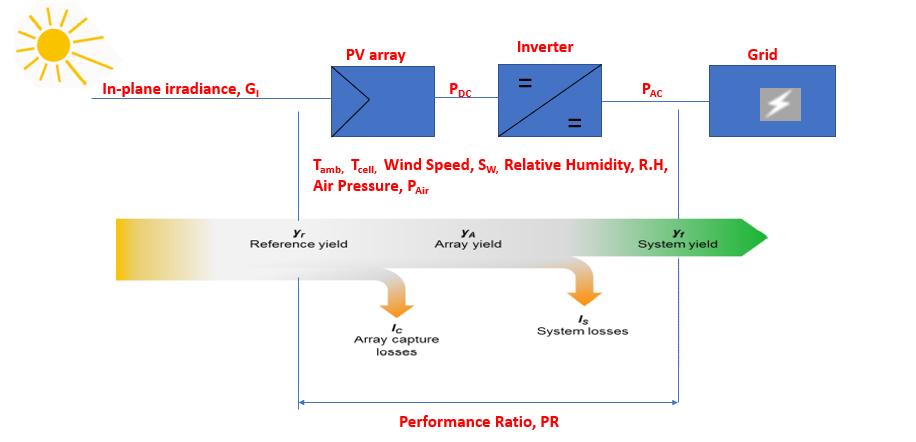
3 minute read
Equation
from INFLUENCE OF SITE AND SYSTEM PARAMETERS ON THE PERFORMANCE OF ROOF-TOP GRID-CONNECTED PV SYSTEMS INS
International Research Journal of Engineering and Technology (IRJET) e-ISSN: 2395-0056 Volume: 09 Issue: 02 | Feb 2022 www.irjet.net p-ISSN: 2395-0072
INFLUENCE OF SITE AND SYSTEM PARAMETERS ON THE PERFORMANCE OF ROOF-TOP GRID-CONNECTED PV SYSTEMS INSTALLED IN HARLEQUINS, BELFAST, NORTHERN IRELAND.
Advertisement
Chibuisi C. Okorieimoh1,2, Brian Norton1, Michael Conlon1, Desmond Lalor3, Ciaran McNamara3
1Dublin Energy Lab, Technological University Dublin, School of Electrical, Electronic Engineering, Grangegorman, Dublin 7, Ireland. 2School of Multidisciplinary Technologies, Bolton Street, Dublin 1, Ireland. 3Electric Supply Board (ESB) Networks, Dublin, Ireland. ------------------------------------------------------------------------*** -----------------------------------------------------------------------ABSTRACT: The problem of energy scarcity has hit a global scale because of the dependency of most of the energy generation on non-renewable sources (e.g., fossil fuels). As in supply and demand laws, the lower the amount of energy provided, the more expensive it becomes, causing a major problem for the industry in general, which is dependent on it. These non-renewable energy sources contribute to environmental degradation effects and depletion of the ozone layer from the atmosphere. To reduce this effect, the use of renewable energy sources which is environmentally friendly has been on the growing index across the globe.
Solar photovoltaic cells transform solar energy into electrical energy through the photovoltaic effect. Solar energy can minimise the carbon dioxide (CO2) emissions associated with the generation of electricity from fossil fuels since the only CO2 emissions associated with the generation of fossil fuels are those in their production. Solar PV electricity is more environmentally friendly since it is carbon-free at the point of generation compared to fossil fuel generation.
In this paper, we examine the various site and system parameters thatinfluencethe performance of the 49.92 kWp rooftop grid-connected PV system installed at Harlequins, Belfast, Northern Ireland using a five-year dataset (from 20172021). The site parametersexaminedare ambient temperature, relative humidity, irradiation, wind speed and air pressure while the systemparameters examined areinverter efficiency, system performance ratio, system efficiency, fill factor, DC array and AC final yields, DC array capture loss, AC system loss and normalised output power efficiency. The result of our analysis shows that an increase in ambient temperature, solar cell temperature, relative humidity and solar irradiation decreases the PV system performance output while an increase in wind speed reduces both ambient and solar cell temperatures but increases dust accumulation on the surface of the solar panel. An increase in air pressure increases the solar irradiation and AC power output generations.
KEYWORDS: Ambient temperature, Solar cell temperature, System performance, Normalised output power efficiency, Solar irradiation, Fillfactor, Relative humidity, Wind speed, Air pressure, Efficiency.
1. INTRODUCTION
The problem of energy scarcity has hit aglobal scalebecause ofthe dependency of most of the energy generationon nonrenewable sources (e.g.,fossil fuels)[1].As in supply and demand law, the lower the amount of energy provided, the more expensive it becomes, causing a major problem for the industry in general, which is dependent on it [1]. These nonrenewable energy sources contribute to environmental degradation effects and depletion of the ozone layer from the atmosphere. To minimise this effect, the use of renewable energy sources which is environmentally friendly has been on the growing index across the globe.
Solar photovoltaic cells transform solar energy into electrical energy. Solar energy can minimise the carbon dioxide (CO2) emissions associated with the generation of electricity from fossil fuels since the only CO2 emissions associated with the generation of fossil fuels are those in their production [2]. Solar PV electricity is more environmentally friendly since it is carbon-free at the point of generation compared to fossil fuel generation [3]. The efficiency of the PV system increases with solar irradiance at a constant temperature because the greater number of photons generated by higher solar irradiance creates more electron-hole pairs leading to more current [4]. Performance ratio (PR) is a measure of the quality of a solar PV system independent of location or solar irradiance. It is often referred to as a quality factor. PR compares the actual and theoretical energy outputs of a PV system [5]. The nearer a PR approaches 100%, the more efficiently the respective PV system will be utilising the available solar energy resource. Because of unavoidable optical losses, PV array losses, DC to AC conversionlosses, cabling losses, dust, shade, wind speed, ambient temperature, or module temperature [6], actual PR values are about 80% for well-operating PV systems [7]. Transient increases in PV cell ambient temperature led to



